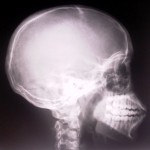April 3rd, 2010
by Jennifer Bunn, RN
The temperomandibular joint is not a joint that is commonly affected by arthritis, but when it is it can cause considerable pain and dysfunction. Talking, swallowing and chewing can become very painful activities, and because it is almost impossible to rest this joint, pain may be unrelenting.
 The TMJ is the joint that joins the mandible (lower jaw) to the skull, so pain in this area can also cause pain in the ear. People who experience TMJ pain often believe that the source of their pain is their teeth. If someone is already known to have arthritis, the problem is generally easier to diagnose.
The TMJ is the joint that joins the mandible (lower jaw) to the skull, so pain in this area can also cause pain in the ear. People who experience TMJ pain often believe that the source of their pain is their teeth. If someone is already known to have arthritis, the problem is generally easier to diagnose.
Pain can often be relieved with pain medication and heat, which may relax the joint. When these remedies fail, doctors may opt to perform arthrocentesis, flushing the joint with anesthetic and sterile fluids to rid the joint of any fluids that result from inflammation. They may instill steroids to counter any further inflammation. If this procedure is unsuccessful, surgeons may opt to perform arthroplasty, sometimes replacing the joint completely. Although arthroplasty is generally successful, it is not without risk, and less invasive measures should be attempted first.
TMJ pain can cause considerable pain and distress to the person who experiences it. Early diagnosis and treatment can result in improved function of the joint and relief of pain.
PreArthros is a twice-daily botanical formulation designed to ease arthritis pain naturally, with no side effects.
Source: TMJ Disease
April 1st, 2010
by Jennifer Bunn, RN
Celiac disease is an autoimmune disorder that affects the small intestine and absorption of nutrients from food. Also known as celiac sprue, the disease is really an intolerance to gluten, a component of wheat, rye and barley. When people with celiac disease eat gluten, it sets off an inflammatory response in their bowel, resulting in destruction of intestinal villi, the tiny finger-like projections of the bowel wall which allow nutrients from food to be absorbed into the body. Celiac disease is both a food intolerance and a malabsorption disease.
Celiac disease is a hereditary disease and can be triggered by numerous events, such as infection, stress, surgery or pregnancy. People with celiac disease may also be more prone to develop other disorders such as type 1 diabetes, rheumatoid arthritis, thyroid disease, liver disease, Sjogren’s syndrome and Addison’s disease. In the United States, it is estimated that 1 in 133 people have the disease. The disease can be mild or very severe, and the reason for its variability in expression is not fully understood.
Symptoms of celiac disease vary from person to person. Children are more likely to experience digestive complaints, such as:
- Weight loss
- Diarrhea
- Constipation
- Bloating
- Vomiting
- Pale or fatty stools
Adults may experience more systemic symptoms:
- Anemia of iron deficiency
- Fatigue
- Arthritis
- Osteoporosis
- Infertility
- Mouth sores
- Tingling in hands and feet
- Joint pain
- Infertility
Celiac disease can be diagnosed by a simple blood test or by a biopsy of the small bowel. Once a person has been diagnosed with celiac disease, the only treatment is the avoidance of foods containing gluten. Avoiding gluten will allow the intestine to heal. This may take several months in children and several years in some adults.
March 30th, 2010
by Jennifer Bunn, RN
Although the two disorders may seem to be worlds apart, research has shown that men who suffer fro erectile dysfunction (ED) have a much higher risk of developing heart disease. Why is this?
 The answer lies in the commonality of the two health conditions. Erectile dysfunction is often a result of damage to the blood vessels that supply blood to the penis, resulting in difficulty getting and maintaining an erection. Long thought to be due mainly to psychological factors, it is now recognized that ED can result from problems with blood flow. Many men seek help from their doctor when they experience ED and are prescribed medications that improve ED by improving blood flow. However, research shows that many men (and doctors) do not take into account that the same issue that results in inability to achieve an erection may be occurring elsewhere in the body, including the heart and its associated blood vessels.
The answer lies in the commonality of the two health conditions. Erectile dysfunction is often a result of damage to the blood vessels that supply blood to the penis, resulting in difficulty getting and maintaining an erection. Long thought to be due mainly to psychological factors, it is now recognized that ED can result from problems with blood flow. Many men seek help from their doctor when they experience ED and are prescribed medications that improve ED by improving blood flow. However, research shows that many men (and doctors) do not take into account that the same issue that results in inability to achieve an erection may be occurring elsewhere in the body, including the heart and its associated blood vessels.
Men who experience ED should be screened for cardiovascular disease. Because the blood vessels of the penis are smaller than those that supply the heart, ED may show up before a problem with the heart is detected. Nevertheless, ED should prompt physicians to actively search for blood vessel disease or cardiovascular disease elsewhere in the body. Examining risk factors for cardiovascular disease may be the first step in this process. Men with ED should be assumed to have heart disease until proven otherwise; actively screening for heart disease in men with ED may prevent deaths from cardiac disease.
Source: Erectile dysfunction is strong predictor of fatal heart ailments, study finds
March 28th, 2010
by Jennifer Bunn, RN
Anyone entering into middle age and beyond is at higher risk of developing osteoporosis, a condition in which bones become fragile and are more prone to breaking. People who have osteoporosis may sustain fractures of their spine, hips and wrists with very little provocation. Both men and women can develop osteoporosis, but the condition occurs more commonly in women who are in perimenopause or menopause and beyond, due to declining estrogen levels.
Although some risk factors can’t be changed (i.e. age, sex, heredity, race), there are some risks for developing osteoporosis that can be modified, such as:
- Smoking
- Diet
- Exercise
- Alcohol intake
 Exercise can be a powerful tool in the prevention of osteoporosis. Specifically, exercise which involves weight bearing, or impact loading exercises, act on the bones by stressing bones, forcing them to remodel and strengthen themselves. Examples of weight bearing exercises include walking, aerobics, jogging, lifting weights, skiing and even yoga.
Exercise can be a powerful tool in the prevention of osteoporosis. Specifically, exercise which involves weight bearing, or impact loading exercises, act on the bones by stressing bones, forcing them to remodel and strengthen themselves. Examples of weight bearing exercises include walking, aerobics, jogging, lifting weights, skiing and even yoga.
Incorporating regular impact loading exercise into your daily routine, as well as ensuring a healthy diet high in calcium, vitamin D and other minerals important to bone health, can help you avoid the development of osteoporosis.
Source: Osteoporosis (MedicineNet)
March 27th, 2010
by Jennifer Bunn, RN
People are aware that certain tastes evoke certain responses: sweet foods are more palatable than some bitter foods; some people crave salty foods while others prefer sweets. The five tastes that humans are able to differentiate are sweet, salt, bitter, sour and foods that are high in protein (also referred to as umami).
 Researchers have discovered that humans can differentiate a sixth flavor: namely, fat. Furthermore, people that are hypersensitive to the flavor of fat are less likely to eat foods with high fat content. Conversely, those people less able to differentiate the taste of fat were more likely to eat foods high in fat, and were also more prone to being overweight and to having a higher BMI (body mass index).
Researchers have discovered that humans can differentiate a sixth flavor: namely, fat. Furthermore, people that are hypersensitive to the flavor of fat are less likely to eat foods with high fat content. Conversely, those people less able to differentiate the taste of fat were more likely to eat foods high in fat, and were also more prone to being overweight and to having a higher BMI (body mass index).
This research is interesting because it holds the possibility of developing new ways to help people lose weight, by altering their sensitivity to the taste of fat. In addition, this research could lead to the development of new foods that are low in fat but are still palatable to those trying to lose weight. Manipulating this new knowledge in a way that targets taste perceptions may offer new avenues to weight loss.
Source: Discovery of ‘Fat’ Taste Could Hold the Key to Reducing Obesity
March 26th, 2010
by Jennifer Bunn, RN
Identification of diabetes is accomplished through the use of tests that measure glucose levels after a person has ingested glucose (oral glucose tolerance test) or levels of glucose in the blood after fasting for a number of hours (fasting plasma glucose test). The HgA1c test is a relative newcomer to the diabetes testing arena.
Scientists now believe that the HgA1c test, which is a measure of glucose attached to hemoglobin, the cells that carry oxygen in the blood, may be a more accurate way of both diagnosing diabetes and controlling it. The HgA1c test provides a picture of glucose levels for the preceding 2 or3 months, and varies less that fasting glucose levels. Thus, the HgA1c test can be administered with no preparation by the patient and provides a clearer picture of glucose control over the long term.
Normal levels of HgA1c are less than 5.0 for people who do not have diabetes. Those whose levels are between 5.0 and 6.25 are said to be pre-diabetic, and are at risk of developing diabetes without modification of risk factors (i.e. weight loss). Levels greater than 6.25 indicate diabetes. Researchers believe that measuring HgA1c is a more accurate diagnostic tool and is also of greater value in monitoring those who already have diabetes.
PreCrea is an all-natural botanical formula taken to reduce blood sugar levels and promote weight loss. It can be used by those who have been diagnosed with pre-diabetes to help them avoid developing type 2 diabetes.
Source: Glycated Hemoglobin Tests See Increasing Use
March 25th, 2010
by Jennifer Bunn, RN
Angiograms are the definitive test for people who may have had a heart attack, or who suffer from chest pain. A normal angiogram virtually rules out the possibility of a heart attack. However, a new study finds that this invasive and expensive test yields far fewer positive results than previously thought.
Researchers studied almost 399,000 patients seen in 663 hospitals over a four-year period. What they found was surprising: only 38% of those undergoing angiograms were found to have blocked arteries. Those patients who had had non-invasive tests prior to angiogram with a positive finding (such as an abnormal stress test) were moderately more likely to have blockage of their arteries discovered on angiogram. Researchers noted that risk factors for finding blockage on angiogram were the same risk factors for cardiovascular disease, including:
- Being male
- Being of older age
- Being diabetic
- Having elevated cholesterol levels
Given that angiograms are both expensive and invasive, it would seem that more stringent criteria is needed to determine who requires an angiogram and who does not. It may be that the culture of practicing defensive medicine is responsible for the number of angiograms done on people with normal findings. It is important to keep in mind that angiograms themselves are not without risk, including the risk of bleeding, and should be reserved for those who truly need it.
Source: Obstructive Disease Not Found on Most Angiograms
March 24th, 2010
by Jennifer Bunn, RN
 Fatigue can be one of the more disturbing aspects of perimenopause, affecting women to a significant degree and impacting all areas of life, including physical, emotional, and social aspects. Many women describe the fatigue of menopause as “crushing” and find it difficult to cope with daily life. Fatigue can also worsen other symptoms of perimenopause, or the perception of these symptoms.
Fatigue can be one of the more disturbing aspects of perimenopause, affecting women to a significant degree and impacting all areas of life, including physical, emotional, and social aspects. Many women describe the fatigue of menopause as “crushing” and find it difficult to cope with daily life. Fatigue can also worsen other symptoms of perimenopause, or the perception of these symptoms.
Fatigue in perimenopause is thought to be a result of decreasing levels of sex hormones, particularly estrogen and progesterone, which may cause sleep disturbances. Difficulty falling asleep and staying asleep may occur, and hot flashes that strike in the night (night sweats) may add to the problem.
There are some things that may help, including:
- Keeping your room at a comfortable temperature- staying cool during sleep may help you avoid night sweats. Try using a fan or keeping the window open, as well as avoiding sheets that may increase sweating, such as silk sheets.
- Stick to a routine- keeping to a regular routine may help you get a better sleep. Go to bed at the same time every night. Try a relaxing activity before sleeping, such as reading or meditating.
- Avoid stimulants close to bedtime- avoid drinking alcohol, smoking, or exercising right before bed, as these activities may stimulate you, making it more difficult to fall asleep.
- Nap during the day- a short nap during the day may recharge your batteries and leave you feeling refreshed. Avoid sleeping long periods of time during the day, as this may make it more difficult to fall asleep at night.
PreMenora and PreMenora+ are all-natural botanical supplements formulated to decrease unpleasant symptoms of perimenopause, including fatigue.
March 23rd, 2010
by Jennifer Bunn, RN
As we age and enter perimenopause, falling estrogen levels result in thinning of vaginal tissue, causing familiar symptoms for some women: burning, itching and dryness. Vaginal dryness can be particularly problematic for women in terms of intimacy. Women may notice that, as they enter into perimenopause, their level of moisture during intercourse may dramatically decrease. Some women experience discomfort during vaginal penetration, a reduction in pleasure and even a small amount of bleeding during or after intercourse.
Vaginal dryness need not signal an end to intimacy. There are products available to ease the discomfort of vaginal dryness. Using a water-based lubricant will replace moisture temporarily and increase comfort. Vaginal moisturizers applied regularly can keep the vaginal tissues moist and supple. There are many brands available, and several may need to be tried before finding the right one. Should neither of these remedies ease the symptoms, a visit to the doctor may be in order to rule out any other problems that may be causing the symptoms, such as a urinary tract infection.
Some women prefer to use natural supplements to ease the symptoms of perimenopause, including vaginal dryness. PreMenora is an all-natural twice daily formulation of 10 different ingredients created specifically to target the symptoms of perimenopause. To learn more about how PreMenora and PreMenora+ can relieve menopausal symptoms, visit http://premenora.predisease.com/.
March 22nd, 2010
by Jennifer Bunn, RN
One minute you are comfortably cool, the next you are sweaty, hot and miserable. Sound familiar? Hot flashes are one of the most common and unpleasant of perimenopause symptoms. What can be done to cope with them? Here are a few suggestions:
- Wear appropriate clothing- wearing clothes that keep you cool and that easily absorb moisture can help you feel more comfortable when a flash hits. Cotton is your friend: avoid wearing clothes that you may overheat in, such as nylon or polyesters. Adopt the “layered look” so that you can shed unwanted clothing and still be fully dressed!
 Cool down with water- Staying well-hydrated is important, but water can have different uses here. Try applying cool compresses to your skin when you become overheated. Using key areas, such as the back of the neck, wrists, forehead and even the groin may provide some relief. Running cold water over your wrists or rinsing your face in cool water may stop a flash in its tracks.
Cool down with water- Staying well-hydrated is important, but water can have different uses here. Try applying cool compresses to your skin when you become overheated. Using key areas, such as the back of the neck, wrists, forehead and even the groin may provide some relief. Running cold water over your wrists or rinsing your face in cool water may stop a flash in its tracks.- Don’t smoke- thin women who smoke are more likely to have more frequent and intense hot flashes, according to some studies. Quitting smoking may decrease the frequency of hot flashes.
- Avoid triggers- triggers may be different for each woman; the key is in determining what your specific triggers are. Common triggers are alcohol, spicy foods, hot tubs, caffeine and stress.
- Manage your stress- stress may trigger hot flashes, so finding ways to cope with stressful situations may help you to cope more effectively with hot flashes. Controlled breathing, meditation, massage, exercise…all are ways to help you feel calmer and more in control of your body.
- Remind yourself that menopause won’t last forever- although it may feel like forever, even the symptoms of menopause must come to an end. They will not last forever, thankfully, so remind yourself that “this, too, shall pass”.
PreMenora is a twice-daily natural botanical formula designed to relieve many of the symptoms of perimenopause, such as hot flashes.
 The TMJ is the joint that joins the mandible (lower jaw) to the skull, so pain in this area can also cause pain in the ear. People who experience TMJ pain often believe that the source of their pain is their teeth. If someone is already known to have arthritis, the problem is generally easier to diagnose.
The TMJ is the joint that joins the mandible (lower jaw) to the skull, so pain in this area can also cause pain in the ear. People who experience TMJ pain often believe that the source of their pain is their teeth. If someone is already known to have arthritis, the problem is generally easier to diagnose.




